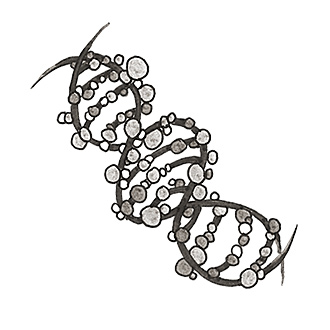
Related Questions
- Why don’t we get cancer of the hair or the fingernails?
- Must all organisms age and die?
- How do doctors detect cancer in the human body?
- How could biotechnology affect sports in the future?
- What makes nerve gas so dangerous?
- Why do I have to take some medications every four hours but others only once a day?
- If I have a high risk of cancer, can my genes be modified to avoid it?
- How do glucometers work?
- Can medical prostheses advance further, and what are their potential risks?
- Do humans emit radiation?
How does a random group of molecules form a thinking, breathing human?
Let’s focus on the first half of the question. Answer: networking…
By Jason M. Rubin“The molecules from which we are derived are very highly evolved and organized,” says Charles Jennings, director of the neurotechnology program at the McGovern Institute for Brain Research at MIT. And enabling a being to be sentient (thinking) is a different molecular challenge than enabling a being to be alive (breathing), Jennings adds. For our question, let’s focus on the former.
“The brain is really two subjects,” Jennings says. “There is the brain as an organ — what it is made of physically and how it works. Plus, there is the more subjective and mysterious sense of the mind as the realm of consciousness, including things like memory and imagination.”
This much we know: The human brain contains 100 billion neurons, and each one was formed through a process of division from a single cell. Complex networks of neurons, along with even more non-neuronal glial cells that support and protect neuron cells, work together to carry the majority of information within the brain. Each of these hundreds of billions of cells, Jennings explains, makes thousands of connections to other neurons, and through these connections produces sensory perception, enables cognition, and initiates action. “The brain is a remarkably efficient machine that receives input from the environment and processes it on the fly,” he says, “integrating sensory inputs with prior experience and knowledge, and making decisions about what to do — what instructions to send to the rest of the body.”
Along with being an efficient machine that can execute commands, the brain is also able to attain and store new information through a complex process — involving many more types of highly evolved molecules. “Patterns in the brain are built from experience,” Jennings says. “Long-time changes in the properties of synaptic connections underlie learning and memory. Things get overwritten constantly, so we forget much of what we take in, but the things we retain tend to be things we learned by repetition or because there is an emotional component that gives it greater importance.”
While it’s generally believed that kids are able to learn things like new languages more quickly than older people, our brains accommodate learning at any age. “People underestimate the plasticity of the brain,” Jennings says. “The reality is that kids spend their time actively learning, whereas adults fall into a routine of work and responsibility. But if adults were motivated to learn they would discover they have the ability to do so. Even seniors can continue to acquire new knowledge.”
Thanks to 14-year-old Cathy Bai from Shenzhen, China, for this question.
Posted: December 16, 2008